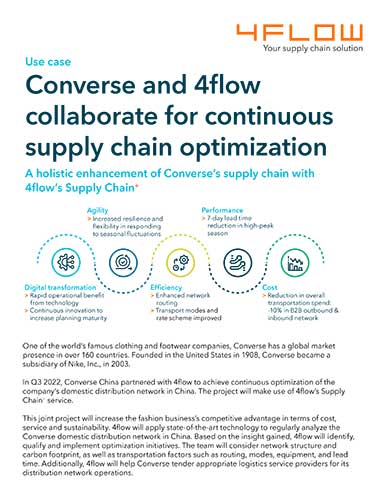How Businesses Can Strengthen Their Supply Chains & Build Future-Ready Supply Networks

The past few years have highlighted weaknesses in global supply chain networks and taught us important lessons along the way.
Supply Chains of Tomorrow: Building Future-Ready Supply Networks
Supply chains are faced with constant challenges. Recent crises such as the Coronavirus pandemic or the war in Ukraine have demonstrated the wide-reaching effects unexpected events can have on the global economy. Supply chains are affected, as well. Shortages and political conflicts highlight dependencies on individual countries and inspire new ways of thinking about supply chain management.
Even supply chain visionaries like the technology giant Apple must reconsider their production strategy for optimal supply chain management. Its network of suppliers, which for the most part only manufacture Apple products, is largely located in China. 95% of all iPhones, iPods, Macs, and AirPods are produced there.(1)
Read: Is Apple’s Supply Chain Really the No. 1? A Case Study
The resulting dependency on Chinese production puts the resilience of Apple’s supply chain at risk. Amid increasing volatility, resilience has become one of the most important goals of supply chain management. That’s why Apple has already begun to relocate its production to other countries – though the percentage of manufacturing outside China is still in the single digits.
Now Is the Right Time to Rethink Supply Chains
The economy is recovering from the Coronavirus pandemic, and the pressure on global supply networks is beginning to return to normal levels – making now the time to address the problems in the supply chain. The past few years have highlighted weaknesses in global supply chain networks and taught us important lessons along the way. Like Apple, many other businesses in other industries are adopting a “China + 1” strategy. In this strategy, production is moved to at least one other country – often Vietnam or Malaysia, Apple, India, and Brazil.
In addition to supply chain resilience, sustainability is a topic of global relevance. In this context, minimizing shipping distances to reduce carbon emissions is important. With this goal, many businesses are bringing parts production back to the countries where it was originally performed, to be closer to consumers – so-called reshoring. Similarly, with nearshoring, production is moved to a country close to the target market. This can often be a more cost-effective alternative while still reducing shipping distances.
A similar trend is a friend sharing. In this case, production still takes place in a farther removed place, but in a country that is considered to be less politically risky. These trends can also apply to the selection of supplier locations. Here, too, the goal is to reduce dependency on individual countries and shorten shipping routes.
Government Support Speeds Up the Relocation of Production Sites
State subsidies to encourage the implementation of sustainable technologies and domestic manufacturing, like the Inflation Reduction Act (IRA) and the CHIPS and Science Act in the United States, are causing quick changes in supply chain strategies. Since the passing of these new laws, there has been significantly more domestic production in the US. In Europe, too, reshoring of manufacturing is made more appealing thanks to government programs to support green energy and the EU Chip Law.
The Key Steps Towards the Supply Chains of Tomorrow
To decide how to prepare their supply chains for the future, businesses should answer a few questions.
1. Where Is the Ideal Location for Production?
The first question to answer concerns the appropriate place for manufacturing. If production plants should be brought closer to the target market, costs are often a limiting factor. It’s important to weigh both the availability and costs for labor, production and warehousing sites, energy, and infrastructure for sourcing and distribution.
2. How Can We Consider Sustainability Goals When Selecting Sites?
Especially if sustainability is a main motivation for supply chain redesign, it’s worth considering traditional production sites. For instance, in Europe, the production of renewable energy such as wind energy takes place primarily in northern Germany, Denmark, and Sweden. Industrial businesses are traditionally seated in southern Germany and the Ruhr Valley region.
3. How Can We Design Our Supplier and Sourcing Strategy for Efficiency?
In addition to site optimization, businesses need to create an efficient network of suppliers to balance out seasonal conditions and ensure constant maximum utilization of transportation. Implementing digital tools and designing new processes can help by simplifying the consolidation of shipments.
Second sourcing is an additional concept with a high potential to improve the resilience of a sourcing strategy. It describes the expansion of a supplier network to include an additional supplier, ideally one with a site even closer. Choosing nearby suppliers can help businesses significantly reduce their carbon footprints. And in material sourcing, automatic ordering systems can also boost efficiency.
Businesses that take these steps and rethink their supply chains can increase resilience in their networks and prepare their supply chain management for the future.
Source
(1) Financial Times/Counterpoint Research EMS Insights Service, Forbes
About the Author
Tobias Wurm is the Director of Software Sales at 4flow Software. Supply chain topics have been at the center of his career for the last 20 years and he's glad that supply chain matters have finally reached C-level attention. His home zone is outsourced supply chain operations (Third-Party Logistics Provider/3PL).
Tobias Wurm extended his experience in supply chain software business development with his last assignment focusing on supply chain planning, transport optimization, and transport-optimized material call-offs.













